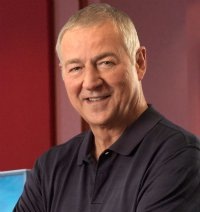Related Research Articles

Frederick Phillips Brooks Jr. was an American computer architect, software engineer, and computer scientist, best known for managing the development of IBM's System/360 family of computers and the OS/360 software support package, then later writing candidly about those experiences in his seminal book The Mythical Man-Month.

Data acquisition is the process of sampling signals that measure real-world physical conditions and converting the resulting samples into digital numeric values that can be manipulated by a computer. Data acquisition systems, abbreviated by the acronyms DAS,DAQ, or DAU, typically convert analog waveforms into digital values for processing. The components of data acquisition systems include:

SPSS Statistics is a statistical software suite developed by IBM for data management, advanced analytics, multivariate analysis, business intelligence, and criminal investigation. Long produced by SPSS Inc., it was acquired by IBM in 2009. Versions of the software released since 2015 have the brand name IBM SPSS Statistics.
Brad J. Cox was an American computer scientist who was known mostly for creating the Objective-C programming language with his business partner Tom Love and for his work in software engineering and software componentry.

SAS Institute is an American multinational developer of analytics and artificial intelligence software based in Cary, North Carolina. SAS develops and markets a suite of analytics software, which helps access, manage, analyze and report on data to aid in decision-making. The company's software is used by most of the Fortune 500.

The Research Triangle, or simply The Triangle, are both common nicknames for a metropolitan area in the Piedmont region of the U.S. state of North Carolina. Anchored by the cities of Raleigh and Durham and the town of Chapel Hill, the region is home to three major research universities: North Carolina State University, Duke University, and the University of North Carolina at Chapel Hill, respectively. The "Triangle" name originated in the 1950s with the creation of Research Triangle Park located between the three anchor cities, which is the largest research park in the United States and home to numerous high tech companies.
Axiom is a free, general-purpose computer algebra system. It consists of an interpreter environment, a compiler and a library, which defines a strongly typed hierarchy.

SAS is a statistical software suite developed by SAS Institute for data management, advanced analytics, multivariate analysis, business intelligence, criminal investigation, and predictive analytics. SAS' analytical software is built upon artificial intelligence and utilizes machine learning, deep learning and generative AI to manage and model data.

The Upstate, historically known as the Upcountry, is a region of the U.S. state of South Carolina, comprising the northwesternmost area of the state. Although loosely defined among locals, the general definition includes the 10 counties of the commerce-rich I-85 corridor in the northwest corner of South Carolina. This definition coincided with the Greenville-Spartanburg-Anderson, SC Combined Statistical Area, as first defined by the Office of Management and Budget (OMB) in 2015. In 2023, the OMB issued its most updated definition of the CSA that coincides again with the 10-county region.

Gertrude Mary Cox was an American statistician and founder of the department of Experimental Statistics at North Carolina State University. She was later appointed director of both the Institute of Statistics of the Consolidated University of North Carolina and the Statistics Research Division of North Carolina State University. Her most important and influential research dealt with experimental design; In 1950 she published the book Experimental Designs, on the subject with W. G. Cochran, which became the major reference work on the design of experiments for statisticians for years afterwards. In 1949 Cox became the first woman elected into the International Statistical Institute and in 1956 was President of the American Statistical Association.

James Howard Goodnight is an American billionaire businessman and software developer. He has been the CEO of SAS Institute since 1976, which he co-founded that year with other faculty members of North Carolina State University. As of April 2023, his net worth was estimated at US$7.4 billion, making him the richest person in North Carolina.

Anthony James Barr, aka Tony Barr or Jim Barr, is an American programming language designer, software engineer and inventor. Among his notable contributions are the Statistical Analysis System (SAS), automated lumber yield optimization, and the Automated Classification of Medical Entities (ACME).
TSS/8 is a discontinued time-sharing operating system co-written by Don Witcraft and John Everett at Digital Equipment Corporation in 1967. DEC also referred to it as Timeshared-8 and later the EduSystem 50.
FriCAS is a general purpose computer algebra system with a strong focus on mathematical research and development of new algorithms. It comprises an interpreter, a compiler and a still-growing library of more than 1,000 domains and categories.
Saffron Technology, Inc., was a technology company headquartered in Cary, North Carolina, that developed cognitive computing systems. Their systems use incremental learning to understand and unify by entity the connections between an entity and other “things” in data, along with the context of their connections and their raw frequency counts. Saffron learns from all sources of data including structured and unstructured data to support knowledge-based decision making. Its patented technology captures the connections between data points at the entity level and stores these connections in an associative memory. Similarity algorithms and predictive analytics are then combined with the associative index to identify patterns in the data. Saffron’s Natural Intelligence platform was utilized across industries including manufacturing, energy, defense and healthcare, to help decision-makers manage risks, identify opportunities and anticipate future outcomes, thus reducing cost and increasing productivity. Its competitors include IBM Watson and Grok. Intel purchased the company in 2015, then shuttered it less than 3 years later.

The 1920 United States presidential election in Alabama took place on November 2, 1920, as part of the 1920 general election, in which all 48 states participated. Alabama voters chose twelve electors to represent them in the Electoral College via popular vote pitting Democratic nominee James M. Cox and his running mate, Assistant Secretary of the Navy Franklin Roosevelt, against Republican challenger U.S. Senator Warren G. Harding and his running mate, Governor Calvin Coolidge.

The 1920 United States presidential election in Virginia took place on November 2, 1920. Voters chose twelve representatives, or electors to the Electoral College, who voted for president and vice president. This was also the first presidential election after the passage of the Nineteenth Amendment, which granted women the right to vote throughout the United States, including Virginia.
Amy Helen Herring is an American biostatistician interested in longitudinal data and reproductive health. Formerly the Carol Remmer Angle Distinguished Professor of Children's Environmental Health at the University of North Carolina at Chapel Hill, she is now Sara & Charles Ayres Distinguished Professor in the Department of Statistical Science, Global Health Institute, and Department of Biostatistics & Bioinformatics of Duke University.
Erin E. Blankenship is an American statistician interested in nonlinear models and environmental statistics, and known for her work in statistics education. She is a professor of statistics at the University of Nebraska–Lincoln.
Ralph Ernest Comstock was an American statistician and geneticist known for his work in quantitative genetics.
References
- ↑ Greenberg, Bernard G.; Cox, Gertrude M.; Mason, David D.; Grizzle, James E.; Johnson, Norman L.; Jones, Lyle V.; Monroe, John; Simmons, Gordon D. Jr. (1978), Nourse, E. Shepley (ed.), "Statistical Training and Research: The University of North Carolina System", International Statistical Review, 46: 180–181, doi:10.2307/1402812, JSTOR 1402812
- ↑ Greenberg, et al. Pages 180-181